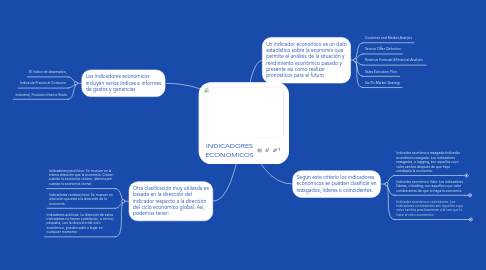
1. Los indicadores económicos incluyen varios índices e informes de gastos y ganancias
1.1. El índice de desempleo,
1.2. Índice de Precios al Consumo
1.3. Industrial, Producto Interior Bruto
2. Otra clasificación muy utilizada es basada en la dirección del indicador respecto a la dirección del ciclo económico global. Así, podemos tener:
2.1. Indicadores procíclicos: Se mueven en la misma dirección que la economía. Crecen cuándo la economía va bien, disminuyen cuándo la economía va mal
2.2. Indicadores contracíclicos: Se mueven en dirección opuesta a la dirección de la economía.
2.3. Indicadores acíclicos: La dirección de estos indicadores no tienen correlación, o es muy pequeña, con la dirección del ciclo económico, pueden subir o bajar en cualquier momento
3. Un indicador económico es un dato estadístico sobre la economía que permite el análisis de la situación y rendimiento económico pasado y presente así como realizar pronósticos para el futuro
3.1. Customer and Market Analysis
3.2. Service Offer Definition
3.3. Revenue Forecast &Financial Analysis
3.4. Sales Execution Plan
3.5. Go-To-Market Strategy
4. Según este criterio los indicadores económicos se pueden clasificar en rezagados, líderes o coincidentes.
4.1. Indicador económico rezagado:Indicador económico rezagado: Los indicadores rezagados, o lagging, son aquellos cuyo valor cambia después de que haya cambiado la economía.
4.1.1. Situational Analysis / Drivers
4.1.1.1. What is driving us to do this?
4.1.1.2. SWOT Analysis
4.1.1.2.1. Strengths
4.1.1.2.2. Weaknesses
4.1.1.2.3. Opportunities
4.1.1.2.4. Threats
4.1.1.3. Customer Findings - What have we learned from customers?
4.1.2. Competitive Analysis
4.1.2.1. Do we have competitors and threats in these target markets with the proposed offerings?
4.1.2.2. What are our competitors doing and how are they positioning?
4.1.2.3. How do we position against each competitor?
4.1.3. Target Customer(s)
4.1.3.1. Buyer Profile
4.1.3.1.1. Title
4.1.3.1.2. Industry
4.1.3.1.3. Geography
4.1.3.1.4. Business Size
4.1.3.2. Influencer Profile
4.1.3.3. User Profile
4.1.3.4. What do customers want and need?
4.1.3.5. What business problems do each of these customers have?
4.1.4. Customer Segmentation
4.1.4.1. Which customers or sets of customers do we sell to?
4.1.4.2. What are the target market segments that we want to go after?
4.1.4.3. What are the distinct problems for each segment of the market?
4.1.5. Total Available Market
4.1.5.1. New Prospects
4.1.5.1.1. How much of each target segment have we penetrated?
4.1.5.1.2. How much opportunity is available in each target segment?
4.1.5.2. Existing Customers
4.1.5.2.1. Can we up-sell existing customers?
4.2. Indicador económico líder: Los indicadores líderes, o leading, son aquellos cuyo valor cambia antes de que lo haga la economía.
4.2.1. Service Offer
4.2.1.1. What are we selling?
4.2.1.2. Product Definition
4.2.1.3. Pricing
4.2.1.4. Packaging
4.2.1.5. Positioning
4.2.2. Value Proposition
4.2.2.1. What is the Value Proposition to the Customer?
4.2.2.2. What pain are we solving?
4.3. Indicador económico coincidente: Los indicadores coincidentes son aquellos cuyo valor cambia practicamente a la vez que lo hace el ciclo económico.
4.3.1. Revenue Forecasts
4.3.1.1. Revenue and P&L Forecast (5 Years)
4.3.1.2. Revenue should be split out quarterly
4.3.2. Cost Analysis
4.3.2.1. Should include a description of the costs in entering this business and profitability analysis
4.3.3. Profitability Analysis
4.3.3.1. P&L for the offer to include gross margin, net income and break even analysis.

